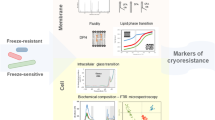Abstract
A morphological examination was undertaken ofLactobacillus casei GR-1 by a freeze substitution technique developed to prevent condensation upon fixation and to preserve extracellular material surrounding the cell wall. The strain was cultured for 24 h in 5% CO2 at 37°C initially in brain heart infusion agar supplemented with 2% yeast extract, and the cells formed a short, electron-dense, tightly bound capsule observed under electron microscopy. The cell wall structure was resolved in most cases. Batch cultures were then established by use of pooled human urine with and without addition of lactose and glucose. Examination of the bacteria demonstrated less compact, but more fibrous extracellular material surrounding the cells in a less uniform fashion. The lactobacilli were then grown under nitrogen-and carbonlimited conditions in a chemostat continuous culture system. The nitrogen-limited cells formed a tightly bound, uniform, and electron-dense capsule, while the capsule of the carbon-limited cells appeared longer, more fibrous, but less electron dense in nature. The results indicate that nutrient conditions affect the morphology of lactobacillus and verify that the freeze substitution technique is a useful method to analyze the structure of bacterial cell surfaces. The importance of nutritional changes in the microbial ecology of the urogenital tract can be uncovered by examining these organisms with different culture techniques combined with freeze substitution and electron microscopy.
Similar content being viewed by others
Literature Cited
Beveridge T, Harris R, Humphrey R (1985) Evaluation of conventional and low temperature techniques for the preservation of bacterial structure. Proc Microscopical Society of Canada, Fredericton, New Brunswick, vol 12, p 22
Chan R, Acres SD, Costerton JW (1982) Use of specific antibody to demonstrate glycocalyx, K99 pili, and the spacial relationships of K99+ enterotoxigenicEscherichia coli in the ileum of colostrum-fed calves. Infect Immun 37:1170–1180
Chan R, Acres SD, Costerton JW (1984) Morphological examination of cell surface structures of enterotoxigenic strains ofEscherichia coli. Can J Microbiol 30:451–460
Chan RCY, Bruce AW, Reid G (1984) Adherence of cervical, vaginal and distal urethral normal microbiol flora to human uroepithelial cells and the blockage of adherence of uropathogens by competitive exclusion. J Urol 131:596–601
Chan RCY, Reid G, Irvin RT, Bruce AW, Costerton JW (1985) Competitive, exclusion of uropathogens from uroepithelial cells byLactobacillus whole cells and cell wall fragments. Infect Immun 47:84–89
Cook R, Tannock G, Meech R (1985) The vaginal microflora and nonspecific vaginitis. Proc University of Otago Medical School 63:10–11
Costerton JW, Irvin RT, Cheng K-J (1981) The role of bacterial surface structures in pathogenesis. CRC Rev 8:303–338
Drucker DB, Whittaker DK (1971) Microstructure of colonies of rod-shaped bacteria. J Bacteriol 108:515–525
Graham LL, Costerton JW (1986) The role of bacterial exopolysaccharides in the adhesion of indigenous urethral flora to human uroepithelium. Proceedings of the 36th Annual Meeting of the Canadian Society of Microbiologists. Toronto, Canada, June 8–11, Abstr. #IN 9p, p 91
Knox KW, Wicken AJ (1984) Environmentally, induced changes in the surfaces of oral streptococci and lactobacilli. Proc. ASM Workshop, Molecular Basis of Oral Microbial Adhesion, Philadelphia, June 5–8, pp 212–219
Marrie TJ, Swantee CA, Hartlen M (1980) Aerobic and anaerobic urethral flora of healthy females in various physiological age groups and of females with urinary tract infections. J Clin Microbiol 11:654–659
Pfau A, Sacks T (1977) The bacterial flora of the vaginal vestibule, urethra and vagina in the normal premenopausal woman. J Urol 118:292–295
Reid G, Sobel JD (1987) Bacterial adherence in the pathogenesis of urinary tract infection: a review. Rev Infect Dis 9:470–487
Reid G, Zorzitto ML, Bruce AW, Jewett MAS, Chan RCY, Costerton JW (1984) The pathogenesis of urinary tract infection in the elderly: the role of bacterial adherence to uroepithelial cells. Curr Microbiol 11:67–72
Reid G, Chan RCY, Bruce AW, Costerton JW (1985) Prevention of urinary tract infection in rats using an indigenous strain ofLactobacillus. Infect Immun 49:320–324
Reid G, Cook RL, Angotti R, Andre JK, Bruce AW (1987) Bacterial interference and the role ofLactobacillus spp. in preventing recurrent urinary tract infection. In: Murakami K, Kitagawa T, Yabuta K, Sakai T (eds), Recent advances in pediatric nephrology. Amsterdam, Holland: Excerpta Medica ICS, 733:265–270
Reid G, Cook RL, Bruce AW (1987) Examination of strains of lactobacilli for properties which may influence bacterial interference in the urinary tract. J Urol 138:330–335
Sautter RL, Brown WJ (1980) Sequential vaginal cultures from normal young women. J Clin Microbiol 11:479–484
Savage DC (1980) Adherence of normal flora to mucosal surfaces. In: Beachey EH (ed) Bacterial adherence: receptors and recognition. London: Chapman & Hall, Series B, vol 6:33–59
Stamey TA, Mihara G (1980) Observations on the growth of urethral and vaginal bacteria in sterile urine. J Urol 124:461–463
Wicken AJ, Broady KW, Ayres A, Knox KW (1982) Production of lipoteichoic acid by lactobacilli and streptococci grown in different environments. Infect Immun 36:864–869
Wicken AJ, Ayres A, Campbell LK, Knox KW (1983) Effect of growth conditions on production of rhamnose-containing cell wall and capsular polysacharides by strains ofLactobacillus casei subsp.rhamnosus J Bacteriol 153:84–92
Author information
Authors and Affiliations
Rights and permissions
About this article
Cite this article
Reid, G., Cook, R.L., Harris, R.J. et al. Development of a freeze substitution technique to examine the structure ofLactobacillus casei GR-1 grown in agar and under batch and chemostat culture conditions. Current Microbiology 17, 151–158 (1988). https://doi.org/10.1007/BF01573471
Issue Date:
DOI: https://doi.org/10.1007/BF01573471




